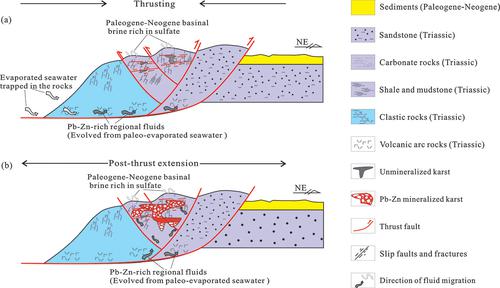当前位置:
X-MOL 学术
›
Acta Geol. Sinica Engl. Ed.
›
论文详情
Our official English website, www.x-mol.net, welcomes your
feedback! (Note: you will need to create a separate account there.)
Geological Characteristics and Genesis of the Jiamoshan MVT Pb–Zn Deposit in the Sanjiang belt, Tibetan Plateau
Acta Geologica Sinica-English Edition ( IF 3.5 ) Pub Date : 2020-08-30 , DOI: 10.1111/1755-6724.14562 Yingchao LIU 1 , Zhusen YANG 2 , Longlong YUE 1 , Yushuai YU 3 , Wang MA 1 , Bolang TANG 4
Acta Geologica Sinica-English Edition ( IF 3.5 ) Pub Date : 2020-08-30 , DOI: 10.1111/1755-6724.14562 Yingchao LIU 1 , Zhusen YANG 2 , Longlong YUE 1 , Yushuai YU 3 , Wang MA 1 , Bolang TANG 4
Affiliation

|
The carbonate‐hosted Pb–Zn deposits in the Sanjiang metallogenic belt on the Tibetan Plateau are typical of MVT Pb–Zn deposits that form in thrust‐fold belts. The Jiamoshan Pb–Zn deposit is located in the Changdu area in the middle part of the Sanjiang belt, and it represents a new style of MVT deposit that was controlled by karst structures in a thrust–fold system. Such a karst‐controlled MVT Pb–Zn deposit in thrust settings has not previously been described in detail, and we therefore mapped the geology of the deposit and undertook a detailed study of its genesis. The karst structures that host the Jiamoshan deposit were formed in Triassic limestones along secondary reverse faults, and the orebodies have irregular tubular shapes. The main sulfide minerals are galena, sphalerite, and pyrite that occur in massive and lamellar form. The ore‐forming fluids belonged to a Mg2+–Na+–K+–SO42––Cl−–F−–NO3−–H2O system at low temperatures (120–130°C) but with high salinities (19–22% NaCl eq.). We have recognized basinal brine as the source of the ore‐forming fluids on the basis of their H–O isotopic compositions (–145‰ to –93‰ for δDV‐SMOW and –2.22‰ to 13.00‰ for δ18Ofluid), the ratios of Cl/Br (14–1196) and Na/Br (16–586) in the hydrothermal fluids, and the C–O isotopic compositions of calcite (–5.0‰ to 3.7‰ for δ13CV‐PDB and 15.1‰ to 22.3‰ for δ18OV‐SMOW). These fluids may have been derived from evaporated seawater trapped in marine strata at depth or from Paleogene–Neogene basins on the surface. The δ34S values are low in the galena (–3.2‰ to 0.6‰) but high in the barite (27.1‰), indicating that the reduced sulfur came from gypsum in the regional Cenozoic basins and from sulfates in trapped paleo‐seawater by bacterial sulfate reduction. The Pb isotopic compositions of the galena samples (18.3270–18.3482 for 206Pb/204Pb, 15.6345–15.6390 for 207Pb/204Pb, and 38.5503–38.5582 for 208Pb/204Pb) are similar to those of the regional Triassic volcanic‐arc rocks that formed during the closure of the Paleo‐Tethys, indicating these arc rocks were the source of the metals in the deposit. Taking into account our new observations and data, as well as regional Pb–Zn metallogenic processes, we present here a new model for MVT deposits controlled by karst structures in thrust–fold systems.
中文翻译:

青藏高原三江带佳磨山MVT铅锌矿床地质特征及成因
青藏高原三江成矿带中碳酸盐岩所含的Pb-Zn矿床是典型的MVT在逆冲褶皱带中形成的Pb-Zn矿床。佳磨山铅锌矿床位于三江带中段的昌都地区,它代表了一种新型的MVT矿床,该矿床由逆冲-褶皱系统中的岩溶构造控制。这样的岩溶控制的MVT Pb-Zn矿床在逆冲环境中以前没有被详细描述过,因此我们绘制了该矿床的地质图并对其成因进行了详细研究。在三叠系石灰岩中,沿次生逆断层形成了喀麦山矿床的岩溶结构,矿体呈不规则管状。主要的硫化物矿物是方铅矿,闪锌矿和黄铁矿,它们以块状和层状形式存在。2+ –Na + –K + –SO 4 2– –Cl -– F -– NO 3 -– H 2 O系统在低温(120–130°C)但高盐度(19–22%NaCl当量。 )。我们已经认识到盆地盐水作为成矿流体h的他们的的基础上,所述源-氧同位素组成(-145‰至-93‰,δ d V-SMOW和-2.22‰至13.00‰,δ 18 ö流体),氯/溴(14-1196)和Na /溴(16-586)中的热流体的比,以及C -方解石为氧同位素组成(-5.0‰至3.7‰ δ 13 C ^ V-PDB和15.1‰至22.3‰,δ 18 ö V-SMOW)。这些流体可能来自深陷在海相中的蒸发海水,也可能来自表面的古近纪-新近纪盆地。的δ 34 S值在在方铅矿(-3.2‰至0.6‰),但在高的重晶石(27.1‰)低,表明减少的硫从石膏在区域新生代盆地和通过从硫酸盐在截留古海水来减少细菌硫酸盐。方铅矿样品的铅同位素组成(18.3270-18.3482为206的Pb / 204铅,15.6345-15.6390为207的Pb / 204 Pb和38.5503-38.5582为208的Pb / 204Pb)与古特提斯闭合期间形成的三叠系火山弧区域岩石相似,表明这些弧岩是沉积物中金属的来源。考虑到我们的新观测和数据,以及区域性的Pb-Zn成矿过程,在这里我们提出了一种由冲断-褶皱系统中的岩溶结构控制的MVT沉积物的新模型。
更新日期:2020-08-30
中文翻译:

青藏高原三江带佳磨山MVT铅锌矿床地质特征及成因
青藏高原三江成矿带中碳酸盐岩所含的Pb-Zn矿床是典型的MVT在逆冲褶皱带中形成的Pb-Zn矿床。佳磨山铅锌矿床位于三江带中段的昌都地区,它代表了一种新型的MVT矿床,该矿床由逆冲-褶皱系统中的岩溶构造控制。这样的岩溶控制的MVT Pb-Zn矿床在逆冲环境中以前没有被详细描述过,因此我们绘制了该矿床的地质图并对其成因进行了详细研究。在三叠系石灰岩中,沿次生逆断层形成了喀麦山矿床的岩溶结构,矿体呈不规则管状。主要的硫化物矿物是方铅矿,闪锌矿和黄铁矿,它们以块状和层状形式存在。2+ –Na + –K + –SO 4 2– –Cl -– F -– NO 3 -– H 2 O系统在低温(120–130°C)但高盐度(19–22%NaCl当量。 )。我们已经认识到盆地盐水作为成矿流体h的他们的的基础上,所述源-氧同位素组成(-145‰至-93‰,δ d V-SMOW和-2.22‰至13.00‰,δ 18 ö流体),氯/溴(14-1196)和Na /溴(16-586)中的热流体的比,以及C -方解石为氧同位素组成(-5.0‰至3.7‰ δ 13 C ^ V-PDB和15.1‰至22.3‰,δ 18 ö V-SMOW)。这些流体可能来自深陷在海相中的蒸发海水,也可能来自表面的古近纪-新近纪盆地。的δ 34 S值在在方铅矿(-3.2‰至0.6‰),但在高的重晶石(27.1‰)低,表明减少的硫从石膏在区域新生代盆地和通过从硫酸盐在截留古海水来减少细菌硫酸盐。方铅矿样品的铅同位素组成(18.3270-18.3482为206的Pb / 204铅,15.6345-15.6390为207的Pb / 204 Pb和38.5503-38.5582为208的Pb / 204Pb)与古特提斯闭合期间形成的三叠系火山弧区域岩石相似,表明这些弧岩是沉积物中金属的来源。考虑到我们的新观测和数据,以及区域性的Pb-Zn成矿过程,在这里我们提出了一种由冲断-褶皱系统中的岩溶结构控制的MVT沉积物的新模型。











































 京公网安备 11010802027423号
京公网安备 11010802027423号